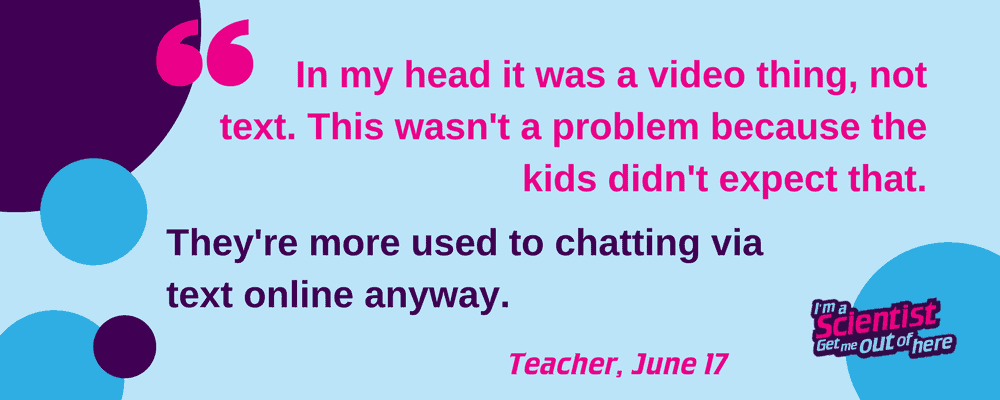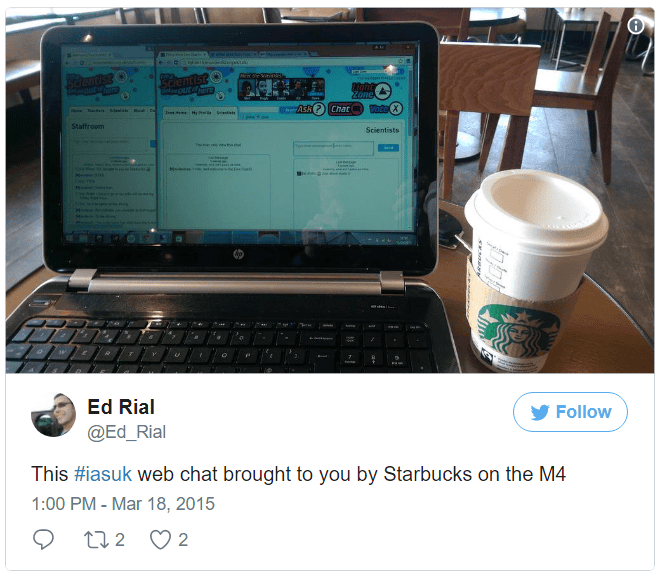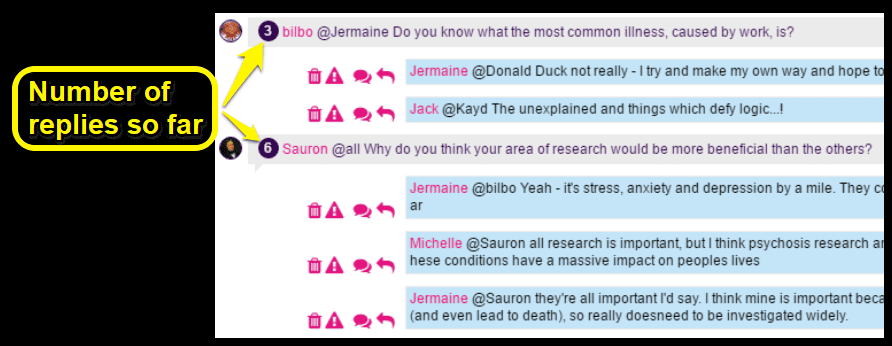This is a question we get asked from time to time. Here we explain why we’re confident that text interaction remains the best format for effective, inclusive, online engagement because
- it makes students and scientists more comfortable,
- levels the playing field between adults and children,
- makes the events accessible to a wider audience.
Students are more familiar with text-based chats.
There is growing evidence¹ that young people communicate most via text and less and less through phone or video and we’re hearing that anecdotally too. Feedback from teachers has pointed out that students are not only more familiar with a text format but also more comfortable with it.
All parties feel more confident about not being visible.
As an ex-teacher myself, the thought of making a class visible online to an unknown person via a webcam makes me uncomfortable. I’d also be concerned about scientists inadvertently displaying confidential or inappropriate material in the background. Text-based chats make it much easier to protect student identity and safeguard young people online.
One teacher told us his students didn’t want to be involved in I’m a Scientist at first because they assumed it would involve webcams and audio. Once he showed the class what the text-based chat looked like, they were much more comfortable and keen to get involved. Consequently these 16 students, who wouldn’t have participated in a video chat, asked 89 questions in their text-based live chat.
Both students and scientists feel less exposed through text-based chats in comparison to audio-visual. For students, this has a huge impact because the fact they are “hidden” gives them the confidence to fully engage with the event and students who are often too shy to speak up in class are able to do so in this environment.
A big part of what we do is break down stereotypes and whilst scientists have a profile picture on the site, the lack of video and sound means students focus less on what the scientists look and sound like and more on what they have to say.
Being text-based also provides an opportunity for scientists to communicate clearly with the students and provide meaningful responses:
Logistically, it’s easier.
A number of scientists have commented on the convenience of text-based chats. With our current model, scientists can take part from their office or usual work environment; having audio-visual chats would make these kind of outreach activities inaccessible to some scientists.
In fact, our current model is so easy to access, scientists have taken part in public places when out of the office, including a motorway service station and Glastonbury festival!
Online outreach activities, both text-based and audio-visual, allow schools to connect with scientists despite being in very different locations; this provides a school with access to hundreds of STEM professionals across a range of roles. Online outreach is especially important for rural schools, but it only works if the schools have the infrastructure to facilitate the projects. A number of our rural schools have previously expressed concerns about bandwidth. Whilst their internet connections are able to cope with text interactions, a video chat would be problematic in these locations.
Our chats are fast-paced but everyone gets their say.
Whilst it is possible to create a video chat with multiple scientists, turn taking would need to take place, losing the fast pace that we currently have in our text-based chats. This means fewer questions answered in the same time frame and less impactful engagement.
A similar challenge occurs when considering how students ask their questions. Undoubtedly the teacher would need to facilitate the session to decide who speaks next and, potentially, which questions should be asked.
This intervention would diminish the excitement element of I’m a Scientist. It would also dissolve the direct link between student and scientist in our events, taking the ownership away from students.
Through our text-based chats, we tackle the ‘those who shout loudest get heard’ issue with chat features and moderators creating a situation where all students get attention. The number of replies a student gets is displayed to scientists and moderators who can then focus on students with fewer replies.
Our events are about more than the live chat.
Through our text-based chats and the two week long events, students not only have time to fully engage and ask questions to the scientists, they also have the chance to build a rapport with the scientists and get a true picture of what their lives entail. Students have access to five experts, providing more breadth and an opportunity to interest more students in the class.
The competition element of our events generates excitement as the students are in charge of who wins and the scientists are fighting for student votes. Much of our feedback from teachers explains how this creates longer-term student engagement than a one off chat. Students continue to talk about I’m a Scientist long after the event finishes – an indicator of the popularity and success of our events.
We could go on but the main point is…
To get the most from outreach opportunities and maximise engagement of all parties, it is essential that students and scientists feel equally comfortable and the format is as accessible as possible. We’re confident that our current text-based chat model is the best way to do this.
If you would like to talk more about our reasons, leave a comment or email jen@mangorol.la, we’d love to hear what you think.
¹A 2014 Ofcom report found that children aged 12-15 spend over 50% of their communication time on text messages, compared to just 6% on phone calls and video calls combined.







